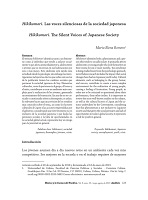Hikikomori. The Silent Voices of Japanese Society
DOI:
https://doi.org/10.32870/mycp.v8i23.561Keywords:
hikikomori, Japanese society, unemployment, youth, crisisAbstract
Hikikomori identifies both a phenomenon and a person who tends to socially isolate. It primarily affects adolescents or young people who lock themselves in their rooms for six or more months. This syndrome is being studied more from the psychology approach; nevertheless research includes the impact that social changes have had on Japanese youth today. Cultural elements, such as belonging to the group, honor, and success, contribute to create a more complex environment for the realization of young people causing a feeling of frustration. Young people, in order not to be criticized or questioned about their performance they rather to isolate. It is important to review the most well-known studies on the subject, as well as the cultural factors of Japan and the actions undertaken by the government; considering that this phenomenon is not exclusive to Japanese society and that given the social pressures and lack of opportunities in today's global society it represents a risk for youth in general.Downloads
References
Brinton, M. C. (2011). Lost in Transition. Youth, Work, and Instability in Postindustrial Japan. New York: Cambridge University Press.
Davies, R.J. & Ikeno, O. (2002). The Japanese Mind. Understanding Contemporary Japanese Culture. Tokyo: Tuttle Publishing.
Doi, T. (2001). The anatomy of dependence: The key analysis of Japanese behavior. Tokyo: Kodansha International Ltd.
Erikson, E. H. (1950). Childhood and Society. New York–London: Norton and Company.
Furlong, A. (2008). The Japanese Hikikomori Phenomenon: Acute Social Withdrawal among Young People. The Sociological Review, 56(2), 309-325. doi: 10.1111/j.1467-954X.2008.00790.x
Horiguchi, S. (2012). Hikikomori: How Private Isolation Caught the Public Eye. In R. Goodman, Y. Imoto, & T. Toivone (Eds.), A Sociology of Japanese Youth: From Returnees to NEETs (pp. 122–138). London & New York: Routledge.
Japan Cabinet Office. (2010). wakamono no ishiki ni kansuru chousa(hikikomori ni kansuru jittai chousa) [Survey of actual conditions of hikikomori] Abridged version. Recuperado de https://www8.cao.go.jp/youth/kenkyu/hikikomori/pdf_gaiyo_index.html
Japan Cabinet Office. (2016). heisei 25 nendo waga kuni to shogaikoku no wakamono no ishiki ni kansuru chousa [La Vida de los Jóvenes” que incluyó jóvenes y adultos entre 15 y 39 años] Recuperado de https://www8.cao.go.jp/youth/kenkyu/thinking/h25/pdf_index.html
Japan Times of News. (7 de enero de 2018). Japan’s first nationwide survey of middle-aged hikikomori in the pipeline. Japan Times of News. Recuperado de https://japan.timesofnews.com/japans-first-nationwide-survey-of-middle-aged-hikikomori-in-the-pipeline.html
Kato, T.A., Tateno M., Shinfuku N., Fujisawa D., Teo AR., Sartorius N., …, Kanba S. (2012). Does the 'hikikomori' syndrome of social withdrawal exist outside Japan? A preliminary international investigation. Social Psychiatry and Psychiatric Epidemiology, 47(7), 1061–1075. Recuperado de https://www.ncbi.nlm.nih.gov/pmc/articles/PMC4909153/ doi: 10.1007/s00127-011-0411-7
Kondo N., Miyazawa H., Sakai M., Kiyota Y., Kitahata Y., … Miyata R. (2008). Shishunki hikikomori ni okeru seishin igakuteki shougai no jittai haaku ni kan suru kenkyuu [Research on the psychiatric disorders in adolescents with social withdrawal] Kokoro no kenkou kagaku kenkyuu. Citado en Teo A. & Gaw, A. (2010). Hikikomori, a Japanese Culture-Bound Syndrome of Social Withdrawal? A Proposal for DSM-5. The Journal of Nervous and Mental Disease, 198(6), 444-449. doi: 10.1097/NMD.0b013e3181e086b1
Kremer, W., & Hammond, C. (5 de julio de 2013). Hikikomori: Why are so many Japanese men refusing to leave their rooms? BBC News. Recuperado de http://www.bbc.com/news/magazine-23182523
Ministry of Health, Labor and Welfare (MHLW). (2003). The concept of hikikomori. Recuperado de https://www.mhlw.go.jp/topics/2003/07/tp0728-1b.html
Ministry of Health, Labor and Welfare (MHLW). (2016). A Survey on the Project for the Establishment and Operation of Regional Support Centers for Hikikomori, (Abnormal Avoidance of Social Contact) Labor and Welfare. Recuperado de http://www.mhlw.go.jp/stf/houdou/0000116367.html
Ohsawa M. (2008). Fukanousei no Jidai. Tokyo: Iwanami Shin-syo (in Japanese). Citado en Suwa, M. & Suzuki, K. (2013). The phenomenon of “hikikomori” (social withdrawal) and the socio-cultural situation in Japan today. Journal of Psychopathology 19, 191-198. Recuperado de http://www.jpsychopathol.it/issues/2013/vol19-3/01b-Suwa.pdf
Saito, T. (2013). Hikikomori. Adolescence without End. [Hikikomori Adolescencia sin fin]. Estados Unidos: University Of Minnesota Press
Sugimoto, Y. (2014). An Introduction to Japanese Society. (4 ed.). Reino Unido: Cambridge University Press. Recuperado de http://assets.cambridge.org/97811076/26676/frontmatter/9781107626676_frontmatter.pdf
Suwa, M., & Suzuki, K. (2013). The phenomenon of “hikikomori ” (social withdrawal) and the socio-cultural situation in Japan today. Journal of Psychopathology 19, 191-198. Recuperado de http://www.jpsychopathol.it/issues/2013/vol19-3/01b-Suwa.pdf
Tajan, N., Yukiko H., & Pionnié-Dax, N. (marzo, 2017). Hikikomori: The Japanese Cabinet Office’s 2016 Survey of Acute Social Withdrawal. The Asia Pacific Journal, 15(5). Recuperado de http://apjjf.org/2017/05/Tajan.html
Tanaka, M. (2016). La juventud japonesa ante la crisis del neoliberalismo. Estudios de Asia y África 51(2), 329-363. Recuperado de https://estudiosdeasiayafrica.colmex.mx/index.php/eaa/article/view/2173 doi: 10.24201/eaa.v51i2.2173
Teo, A. R., & Gaw, A. C. (junio, 2010). Hikikomori, a Japanese Culture-Bound Syndrome of Social Withdrawal? A Proposal for DSM-5. The Journal nervous and mental disease, 198(6) 444–449. doi: 10.1097/NMD.0b013e3181e086b1
Uchida, Y., & Norasakkunkit V. (2014). To Conform or to Maintain Self-Consistency? Hikikomori Risk in Japan and the Deviation From Seeking Harmony. Journal of Social and Clinical Psychology, 33(10), 919-937. doi: 10.1521/jscp.2014.33.10.918
Umeda, M., & Kawakami, N. (marzo, 2012). Association of childhood family environments with the risk of social withdrawal (‘hikikomori’) in the community population in Japan. Psychiatry and Clinical Neurosciences, 66(2), 121-129. doi: 10.1111/j.1440-1819.2011.02292.x

Downloads
Published
How to Cite
Issue
Section
License
Open Access Policy
This journal provides open access to all its contents, in adherence to the principle that making research freely available supports a greater global exchange of knowledge.
MyCP is licensed under a Creative Commons Attribution-NonCommercial license, also known as CC BY-NC.
Contents are published in both PDF and XML formats.
Authors who publish in México y la Cuenca del Pacífico must accept the following conditions:
Pursuant to Mexican copyright laws, México y la Cuenca del Pacífico acknowledges and respects the authors’ moral right and ownership of property rights, which will be assigned to the University of Guadalajara to publish the articles in an open-access mode.
México y la Cuenca del Pacífico does not charge the authors any fees for receiving and processing their articles.
Authors are permitted to enter into other independent and additional contractual agreements for the non-exclusive distribution of the article version published in México y la Cuenca del Pacífico (for example, publishing it in an institutional repository or in other printed or electronic media) as long as they clearly state that the piece was originally published in México y la Cuenca del Pacífico.
Pursuant to the above, once the article is approved for publication, authors must send the Assignment of Rights Agreement form duly filled and signed. This form must be sent to mexicoylacuenca@gmail.com as a PDF file.
Readers/users of México y la Cuenca del Pacífico can freely access the journal new issues as soon as they are uploaded. Readers/users are allowed to cite, share (both electronically and physically), print and distribute the material, provided they expressly state that the work was originally published in México y la Cuenca del Pacífico. Contents are to be properly cited and never for commercial purposes.




